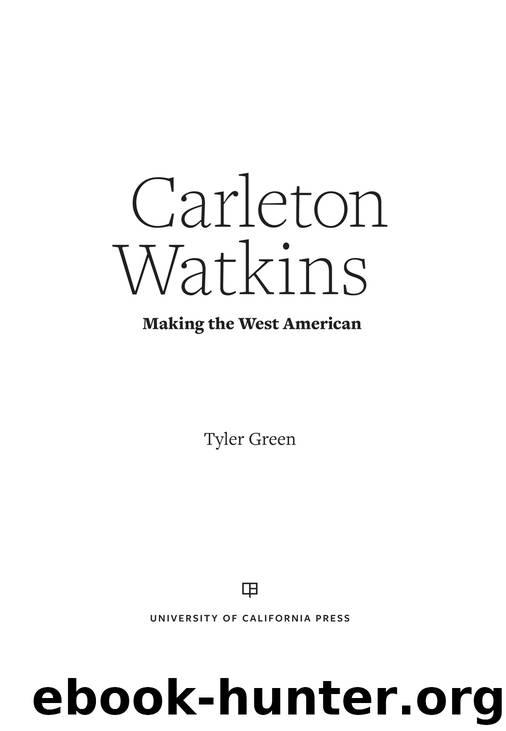Carleton Watkins by Tyler Green

Author:Tyler Green
Language: eng
Format: epub
ISBN: 9780520287983
Publisher: University of California Press
In November 1873, about a year after opening the gallery in the new location, Carleton Watkins made what seems like an odd decision: he decided that late autumn—effectively winter in the mountains—was a good time for his first trip along the transcontinental railroad. He traveled to Utah Territory with friend and fellow Scotsman William Keith, who was in the beginning of what would prove to be a forty-year career as one of the West’s finest painters.
Keith was born in Aberdeenshire, Scotland, in 1838 and emigrated to New York with his family in 1850. Somehow he avoided service in the Civil War and worked as an engraver before studying painting with the same Samuel Brookes, Painter of Fish, whose portrait Watkins would make at the gallery. After Keith moved to California, he cofounded an engraving firm called Van Vleck and Keith. Among the photographs for which Keith made engravings were Watkins’s Yosemite views. Keith started painting western watercolors in 1866 and then, in 1868, traveled to the Pacific Northwest to make paintings for the Oregon Steam Navigation Co. (Watkins may have helped Keith make the transition from engraver to painter by buying him his first paints.)15 After leaving Oregon, Keith traveled to Europe for a few years to study art, returning first to Boston and then to San Francisco. He and Watkins would be close friends from the time Keith returned to California in 1872 until shortly after Keith’s first wife, Elizabeth Emerson, died. (Keith’s second wife, Mary McHenry, seems not to have been a fan of her husband’s friends, and after their marriage, Watkins and Keith seem to have had substantially less contact.)
Keith would become a standout of California’s first generation of painters, a group that included Watkins friends Gilbert Munger, Virgil Williams, Thomas Hill, and, occasionally, Albert Bierstadt. Today Keith’s work is well collected, with fine examples in most of America’s major museums, but still little known. Too bad: while Keith made fewer large-scale paintings than many of his East Coast–based peers (San Francisco’s collector base was smaller than New York’s, and California painters lacked the same access to the European market), his best work compares favorably with theirs. Keith was in almost all of the major California collections of his time, and onetime Californians who moved back east acquired him too. Keith and Watkins shared numerous collectors; Frederick Billings, for one, bought Keith’s ca. 1870–80 Mount Hood from Sandy River, which still hangs in his Woodstock, Vermont, home. While many easterners who traveled west competed with photography by inventing fanciful luminous effects or by amplifying already dramatic scenery into impossibility (Bierstadt especially), Keith instead relied on his vibrant, expressive brushwork and muscular compositions. (Perhaps not coincidentally, Keith owned scores of Watkinses, and the men compared notes.) While Keith seems to have cribbed less directly from Watkins pictures than Bierstadt did, he certainly learned from the Watkinses he owned. Keith’s 1878–79 Donner Lake (St. Mary’s College Museum of Art, Moraga, California) is plainly indebted to Watkins’s mammoth plate of the same subject, as is his later Sentinel Peak and Merced River (also at St.
Download
This site does not store any files on its server. We only index and link to content provided by other sites. Please contact the content providers to delete copyright contents if any and email us, we'll remove relevant links or contents immediately.
The Secret History by Donna Tartt(18158)
Red Sparrow by Jason Matthews(5195)
Harry Potter 02 & The Chamber Of Secrets (Illustrated) by J.K. Rowling(3555)
In a Sunburned Country by Bill Bryson(3364)
Drawing Cutting Edge Anatomy by Christopher Hart(3290)
Figure Drawing for Artists by Steve Huston(3268)
The Daily Stoic by Holiday Ryan & Hanselman Stephen(3109)
Harry Potter and the Prisoner of Azkaban (Book 3) by J. K. Rowling(3109)
Japanese Design by Patricia J. Graham(3000)
The Roots of Romanticism (Second Edition) by Berlin Isaiah Hardy Henry Gray John(2819)
Make Comics Like the Pros by Greg Pak(2757)
Stacked Decks by The Rotenberg Collection(2685)
Harry Potter and the Deathly Hallows (7) by J.K. Rowling(2550)
Draw-A-Saurus by James Silvani(2503)
Tattoo Art by Doralba Picerno(2484)
On Photography by Susan Sontag(2482)
Foreign Devils on the Silk Road: The Search for the Lost Treasures of Central Asia by Peter Hopkirk(2385)
Churchill by Paul Johnson(2360)
The Daily Stoic by Ryan Holiday & Stephen Hanselman(2343)
